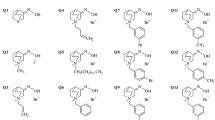Abstract
Organophosphate (OP) nerve agents are known as the most toxic chemical warfare agents that act by inhibiting the enzyme acetylcholinesterase (AChE) and butyrylcholinesterase (BuChE). Because BuChE is present at a level of about 3,900 times higher than AChE in plasma, most OP agents first react with BuChE in plasma, suggesting that OP-inactivated BuChE (OP-iBuChE) may act as a biomarker of OP exposure. In this study, we generated an anti-BuChE monoclonal antibody (mAb) that has reduced binding activity to VX-inactivated BuChE compared to native BuChE by phage display. We performed subtractive biopanning of a synthetic human Fab library against native BuChE and soman-iBuChE or VX-iBuChE. As the results, we isolated four Fab clones that showed differential binding activities to VX-iBuChE and native BuChE in ELISAs. To confirm the antigen-binding specificity of the selected clones, the Fabs were converted to IgG1s, and the IgG antibodies were expressed in HEK293F cells and purified. One of them (A2) showed approximately 30% reduced binding activity to VX-iBuChE compared to BuChE in a dose-dependent manner, whereas the other three antibodies showed almost the same binding activities to VX-iBuChE and BuChE. In addition, the A2 antibody did not show reduced binding activity to sarin-iBuChE or soman-iBuChE compared to native BuChE. The results indicate that A2 antibody shows reduced binding activity only to VX-iBuChE. A2 antibody may be applied to specific diagnosis of VX exposure.
Similar content being viewed by others
References
Terry, A. V. Jr (2012) Functional consequences of repeated organophosphate exposure: Potential non-cholinergic mechanisms. Pharmacol. Ther. 134: 355–365.
Casida, J. E. and G. B. Quistad (2005) Serine hydrolase targets of organophosphorus toxicants. Chem. Biol. Interact. 157-158: 277–283.
Steiner, W. E., C. S. Harden, F. Hong, S. J. Klopsch, H. H. Jr Hill, and V. M. McHugh (2006) Detection of aqueous phase chemical warfare agent degradation products by negative mode ion mobility time-of-flight mass spectrometry. J. Am. Soc. Mass Spectrom. 17: 241–245.
Balali-Mood, M. and K. Balali-Mood (2008) Neurotoxic disorders of organophosphorus compounds and their managements. Arch. Iran Med. 11: 65–89.
Leikin, J. B., R. G. Thomas, F. G. Walter, R. Klein, and H. W. Meislin (2002) A review of nerve agent exposure for the critical care physician. Crit. Care Med. 30: 2346–2354.
Newmark, J. (2007) Nerve agents. Neurol. 13: 20–32.
Moshiri, M., E. Darchini-Maragheh, and M. Balali-Mood (2012) Advances in toxicology and medical treatment of chemical warfare nerve agents. Daru 20:81.
Sidell, F. R. and J. Borak (1992) Chemical warfare agents: II. Nerve agents. Ann. Emerg. Med. 21: 865–871.
Cao, C. J., R. J. Mioduszewski, D. E. Menking, J. J. Valdes, E. J. Katz, M. E. Elderfrawi, and A. T. Eldefrawi (1999) Cytotoxicity of organophosphate anticholinesterases. In Vitro Cell Dev. Biol. Anim. 35: 493–500.
Munro, N. (1994) Toxicity of the organophosphate chemical warfare agents GA, GB, and VX: Implications for public protection. Environ. Health Perspect. 102: 18–38.
Black, R. M. and R. W. Read (2013) Biological markers of exposure to organophosphorus nerve agents. Arch. Toxicol. 87: 421–437.
Lockridge, O. (2015) Review of human butyrylcholinesterase structure, function, genetic variants, history of use in the clinic, and potential therapeutic uses. Pharmacol. Ther. 148: 34–46.
Manoharan, I., R. Boopathy, S. Darvesh, and O. Lockridge (2007) A medical health report on individuals with silent butyrylcholinesterase in the Vysya community of India. Clin. Chim. Acta 378: 128–135.
Jokanovic, M. (2009) Medical treatment of acute poisoning with organophosphorus and carbamate pesticides. Toxicol. Lett. 190: 107–115.
Nordgren, I., G. Lundgre, G. Puu, and B. Holmstedt (1984) Stereoselectivity of enzymes involved in toxicity and detoxification of soman. Arch. Toxicol. 55: 70–75.
Worek, F., U. Mast, D. Kiderlen, C. Diepold, and P. Eyer (1999) Improved determination of acetylcholinesterase activity in human whole blood. Clin. Chim. Acta 288: 73–90.
Shih, T., R. K. Kan, and J. H. McDonough (2005) In vivo cholinesterase inhibitory specificity of organophosphorus nerve agents. Chem. Biol. Interact. 157-158: 293–303.
Adams, T. K., B. R. Capacio, J. R. Smith, C. E. Whalley, and W. D. Korte (2004) The application of the fluoride reactivation process to the detection of sarin and soman nerve agent exposures in biological samples. Drug Chem. Toxicol. 27: 77–91.
Sliwkowski, M. X. and I. Mellman (2013) Antibody therapeutics in cancer. Sci. 341: 1192–1198.
Buss, N. A., S. J. Henderson, M. McFarlane, J. M. Shenton, and L. de Haan (2012) Monoclonal antibody therapeutics: history and future. Curr. Opin. Pharmacol. 12: 615–622.
Waldmann, T. A. (1991) Monoclonal antibodies in diagnosis and therapy. Sci. 252; 1657–1662.
Winter, G., A. D. Griffiths, R. E. Hawkins, and H. R. Hoogenboom (1994) Making antibodies by phage display technology. Annu. Rev. Immunol. 12: 433–455.
Lerner, R. A., A. S. Kang, J. D. Bain, D. R. Burton, and C. F. Baras (1992) Antibodies without immunization. Sci. 258: 1313–1314.
Ellman, G. L., K. D. Coutney, V. Andres, and R. M. Featherstone (1961) A new and rapid colorimetric determination of acetylcholinesterase activity. Biochem. Pharmacol. 7: 88–95.
Dingova, D., J. Leroy, A. Check, V. Garaj, E. Krejci, and A. Hrabovska (2014) Optimal detection of cholinesterase activity in biological samples: Modifications to the standard Ellman’s assay. Anal. Biochem. 462: 67–75.
Kristensen, P. and G. Winter (1998) Proteolytic selection for protein folding using filamentous bacteriophages. Fold Des. 3: 321–328.
Author information
Authors and Affiliations
Corresponding author
Additional information
First two author’s contributed equally to this work.
Rights and permissions
About this article
Cite this article
Yoon, JY., Kim, DH., Kim, S. et al. Generation of a monoclonal antibody that has reduced binding activity to VX-inactivated butyrylcholinesterase (BuChE) compared to BuChE by phage display. Biotechnol Bioproc E 22, 114–119 (2017). https://doi.org/10.1007/s12257-017-0110-7
Received:
Revised:
Accepted:
Published:
Issue Date:
DOI: https://doi.org/10.1007/s12257-017-0110-7




